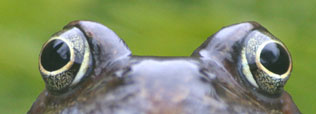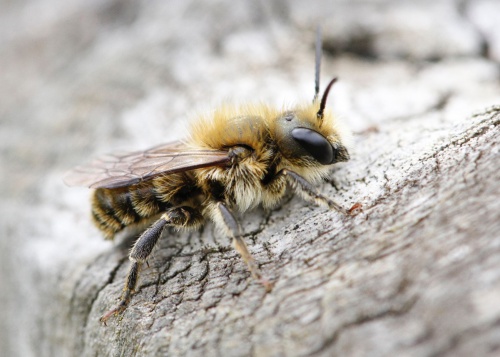Orange-vented Mason Bee - Osmia leaiana
The males of both O. leaiana and O. caerulescens are extremely hard to distinguish, being about 6mm long, shining metallic green and having bright ginger hairs when fresh. The best character is microscopic: look at the downward-sloping front surface of the first gastral tergite. It is shining in O. caerulescens and matt with reticulation in O. leaiana. This means that set specimens need to be arranged in order to see this feature. The females are quite different; both are about 10mm long, but O. caerulescens is generally smaller, dark blue with a black scopa under the abdomen and O. leaiana is generally larger, dark brown, with a bright orange scopa under the abdomen.
Most solitary bees and wasps are difficult to identify, and can rarely be identified from photos taken in the field. All red-rated records should include a photo or set of photos of the specimen, illustrating the key characters taken from a standard key, which should also be referenced (e.g. ‘Falk, 2015’). The full set of key characters are generally not visible in field photos and photos are rarely sharp enough. To aid in the verification of your records, please include face shot, side, top and wings. The notes should state whether male or female, and explain how the specimen met the key characters. Although NS may not be able to identify the species even if these reference photos are provided, the photos will be stored with the record and may allow it be identified in future. Alternatively, NS will accept records identified by a recognised local or national expert, or that have been identified via BWARS’ Facebook https://www.facebook.com/profile.php?id=100065021433202 . If you have obtained this advice, please note the name of the person/organisation identifying the record in the ‘determiner’ field (e.g. ‘Stuart Roberts, BWARS Facebook’) rather than just a comment of ‘BWARS Facebook’.
It uses a wide range of habitats, especially sites with plentiful thistles and knapweeds. It can be frequent in gardens and is one of the species that like to exploit bee hotels.
Between May and August.
Nests in cavities in dead wood, walls or cliffs. Adults collect pollen exclusively from Asteraceae.
Restricted to England and Wales. It is less frequently found than O. caerulescens, but occurs in similar habitats.
Status in Leicestershire and Rutland not known.
Leicestershire & Rutland Map
Enter a town or village to see local records
MAP KEY:
Yellow squares = NBN records (all known data)
Coloured circles = NatureSpot records: 2020+ | 2015-2019 | pre-2015
UK Map
Species profile
- Common names
- Orange-vented Mason Bee
- Species group:
- Bees, Wasps, Ants
- Kingdom:
- Animalia
- Order:
- Hymenoptera
- Family:
- Megachilidae
- Records on NatureSpot:
- 19
- First record:
- 12/07/2013 (Helen Ikin;Steve Woodward)
- Last record:
- 23/06/2022 (Sexton, Timothy)
Total records by month
% of records within its species group
10km squares with records
The latest images and records displayed below include those awaiting verification checks so we cannot guarantee that every identification is correct. Once accepted, the record displays a green tick.
In the Latest Records section, click on the header to sort A-Z, and again to sort Z-A. Use the header boxes to filter the list.







